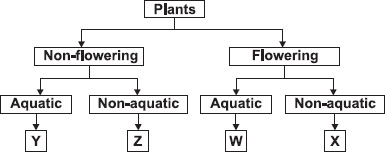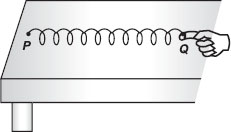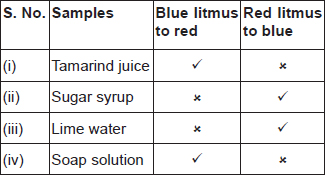Post Your Answer
Ans 3:
Ans 5: (Master Answer)
The correct answer is D
In transverse wave, vibration of a wave is perpendicular to its direction of propagation of wave.
Ans 6:
Ans 10:
Post Your Answer
Ans 2: (Master Answer)
The correct answer is A.
Sugar syrup is neutral and hence the colour of blue litmus and red litmus remains unchanged. Tamarind juice is acidic, so blue litmus turns red but red litmus does not change its colour. Lime water and soap solution are basic in nature which turn red litmus blue whereas blue litmus remains unchanged.
Post Your Answer
Ans 1: (Master Answer)
Fish Y will be least affected as it is camouflaging with the sea weeds. Fish Y can easily escape from the predator by blending with the surrounding environment.
Post Your Answer
Ans 1:
Ans 2:
Ans 3:
Ans 5:
Ans 6:
Ans 14:
Post Your Answer
Post Your Answer
The following table shows some information on four plants, (A), (B), (C) and (D). A tick (√) indicates that the plant shows that particular characteristic.

Based on the information above, which letter, W, X, Y or Z, best represent plants (C) and (D)?

| Plant (C) | Plant (D) | |
| A | W | X |
| B | X | Y |
| C | Y | Z |
| D | Z | W |
Ans 1: (Master Answer)
The correct answer is A.
Both plants ‘c’ and ‘d’ bear fruits. This means they are flowering plants as only flowers change into fruits. Plant ‘c’ grows in water i.e., it is an aquatic plant but plant ‘d’ does not grow in water thus, it is a nonaquatic plant. Hence 'W' and 'X' represent plant ‘c’ and ‘d’ respectively.
Post Your Answer
Ans 4:
Ans 5: (Master Answer)
The correct answer is B
In given figures, both the circuits are tightly connected and both the liquids conduct electricity because both the bulbs are glowing. The bulb in the set up P glows more brightly as compared to that of the set up Q might be because of any of the two possibilities:
1. The liquid in Q may have small conductivity.
2. Liquid in P is equivalent to a battery while liquid in Q is equivalent to a cell of the battery of liquid P.




